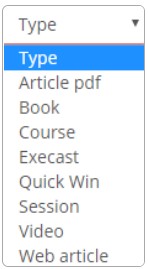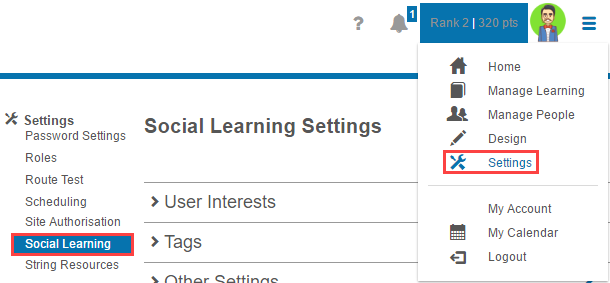Welcome to the Janison Academy help portal
Social Learning
In Social Learning, Tags are used to fulfil different purposes:
In the image example below:
 , star ratings
, star ratings  and comments
and comments  are automatically set to display by the system.
are automatically set to display by the system.
The filters available on the Learn page are set by the system. The lists that appear in some of the dropdowns can be controlled by Tags on Catalogue Items.
Note these filters are not available on the Learning Carousel.
Default filters include Quick Filter, Filter by Interest, Filter By Author, Duration. All other filters can be included via Settings > Social Learning Settings > Tags

This is a default filter. Items in the Quick Filter dropdown are set by the system and include:

This is a default filter. Items in the Filter by Interest dropdown are controlled by the Tags you have set in the Tag Type of Professional Interests. It is also controlled by the Professional Interests selected by the user. For example you may have ten professional interest tags in the system but the learner has only selected 2 in their professional interests. It is only the users selected tags that will appear in this list.

Items in the Type dropdown are controlled by Tags you have set in the Tag Type of Resource Type.

The Duration field is controlled by the values set in the Approx Duration (minutes) field of the Catalogue Item. By adding a duration will assist the learner in planning and allocating their time to undertake the learning.
Default duration ranges include:
This is also referred to as Azure Search and is enabled at a global level. If you would like more information on this feature please contact your Janison Account Manager or Project Team.

The results returned in Search are determined by Tags and three fields of the Catalogue Item.
There is a weighting applied to each item which determines the order in which a user will see results. Tags have the greatest weighting, followed by Name and then Overview and lastly Author.
As a simple example, when we have 4 catalogue Items:
When we search for ‘Elephant’ the Catalogue items will be returned in the following order:
If a Catalogue Item is tagged with Elephant and has Elephant included in the title, it will appear above the Catalogue Item one listed above. This is due to weighting. The Tag weight of 4 + the Name weight of 3 = 7 which is higher than just the Tag which is = to 4.
| Item | Weighting |
|---|---|
| Tags | 4 |
| Name | 3 |
| Overview | 2 |
| Author | 0 |
Note: Tag Types are ignored by the search.
When your organisation subscribes to the Global content library the content is loaded and managed by Janison on the parent site. Local content is loaded and managed locally by the client on their Tenant which is a child of global site.
Content loaded globally is equally searchable as content loaded locally.
There are two means available to stop content from appearing in the search and in the filters:

Note:
There will be a one hour delay before you can see any newly created Catalogue Items. This is due to the time it takes for Azure search to index the content. It will take longer on the Beta site, up to 24 hours.
Tags in the social learning UI are created in the same way as all tags in the system. To read more about tags please refer to the Tags topic.
There are several ways to add tags to the system:
 icon to add each tag.
icon to add each tag. icon to edit the tag.
icon to edit the tag. icon to Save Changes
icon to Save Changes icon to remove the tag.
icon to remove the tag.
Browse to Settings > Social Learning.

 icon in the Tags Section.
icon in the Tags Section.

The Tag Type will be added to a list.
 Filterable. Selecting
Filterable. Selecting  Filterable allows users to filter search results to this Tag Type.
Filterable allows users to filter search results to this Tag Type. icon to remove it from this list.
icon to remove it from this list.
Browse to Manage Learning > Manage Catalogue.


 icon in the Tags section.
icon in the Tags section.
As you type, options will be filtered contextually. At any time you can select one of these options.

Once selected, these Tags are added to the Catalogue immediately. There is no need to select Link New Tag or Cancel.

To Import Catalogue Item Tags you will need to know the Identifier of each Catalogue Item you would like to apply a Tag to. An easy way to gather this information is with a Customisable Report using the Catalogue Item Entity and making sure the Name and Identifier columns are selected. You can also incorporate filters to focus your list of catalogue items.

Read the Customisable Report guide for more details on this feature.
Browse to Manage Learning > Manage Catalogue.


 Template. A template file for Catalogue Item Tag Imports will download.
Template. A template file for Catalogue Item Tag Imports will download.

There are also two columns for Custom Attributes. These do not apply to the standard Tag import and can be removed. 


 select or
select or  clear Allow Tag Type Creation.
clear Allow Tag Type Creation. select or
select or  clear Allow Tag Creation.
clear Allow Tag Creation.Note: These options allow the import process to create tags and tag types from the report if they do not already exist within the system. In this example, we are going to clear them as we are using tags and tag types which already exist within the system and do not want to risk creating tags as a result of spelling mistakes entered into the spreadsheet.

To see the Tag applied to the Catalogue Item, Search from the Home page.

Note: The Tag Type is listed as well as the Tag.
The Tag can also be seen from the Catalogue Item details.

1300 857 687 (Australia)
+61 2 6652 9850 (International)
ACN 091 302 975
ABN 35 081 897 494
© 2024 Janison
Janison acknowledges the traditional owners of the land on which we work and meet. We acknowledge the continuous care of the land, animals and waterways. We pay our respects to Elders past, present and emerging.